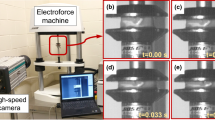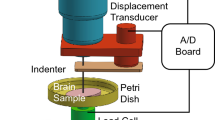Abstract
Most biomechanical models that aim to investigate traumatic brain injury consider the corona radiata as a homogeneous structure. To verify this, indentation–relaxation tests using a custom-designed indentation device were performed on the anterior, superior, and posterior region of the corona radiata in the coronal plane of the porcine brain. Using Boltzmann hereditary integral, a linear viscoelastic model with a Prony series approximation was fitted to the time-dependent shear modulus for different regions of the corona radiata, and the fit parameters were generated. The posterior region was the stiffest and the anterior region was the least stiff. A statistical analysis revealed a significant difference in biomedical properties between the anterior and superior regions, as well as between the anterior and posterior regions in the short time scale. However, the results showed that these differences faded away as the tissue approached equilibrium. No significant difference was observed between the superior and posterior regions along the total time history of relaxation. This is the first demonstration of the regional biomechanical heterogeneity of the corona radiata, and these results will improve future biomedical models of the porcine brain.





Similar content being viewed by others
References
Allen, M. P. Understanding Regression Analysis. New York: Plenum Press, 1997.
Belingardi, G., G. Chiandussi, and I. Gaviglio. Development and validation of a new finite element model of human head. In: Proceedings of the 19th International Technical Conference of the Enhanced Safety Of Vehicle (ESV), Washington, 2005.
Bonferroni, C. E. Il calcolo delle assicurazioni su gruppi di teste. Studi in onore del Professore Salvatore Ortu Carboni. Rome, 13–60, 1935.
Chatelin, S., A. Constantinesco, and R. Willinger. Fifty years of brain tissue mechanical testing: from in vitro to in vivo investigations. Biorheology 47:255–276, 2010.
Cheng, S., E. C. Clarke, and L. E. Bilston. Rheological properties of the tissues of the central nervous system: a review. Med. Eng. Phys. 30:1318–1337, 2008.
Cheng, L., X. Xia, W. Yu, L. E. Scriven, and W. W. Gerberich. Flat-punch indentation of viscoelastic material. J. Polym. Sci. Polym. Phys. 38:10–22, 2000.
Christ, A. F., K. Franze, H. Gautier, P. Moshayedi, J. Fawcett, R. J. M. Franklin, R. T. Karadottir, and J. Guck. Mechanical difference between white and gray matter in the rat cerebellum measured by scanning force microscopy. J. Biomech. 43:2986–2992, 2010.
Darvish, K. K., and J. R. Crandall. Nonlinear viscoelastic effects in oscillatory shear deformation of brain tissue. Med. Eng. Phys. 23:633–645, 2001.
Elkin, B. S., E. U. Azeloglu, K. D. Costa, and B. Morrison, III. Mechanical heterogeneity of the rat hippocampus measured by atomic force microscope indentation. J. Neurotraum. 24:812–822, 2007.
Elkin, B. S., A. Ilankovan, and B. Morrison, III. Age-dependent regional mechanical properties of the rat hippocampus and cortex. J. Biomech. Eng. 132:011010, 2010.
Elkin, B. S., A. Ilankovan, and B. Morrison, III. Dynamic, regional mechanical properties of the porcine brain: indentation in the coronal plane. J. Biomech. Eng. 133:071009, 2011.
Feng, Y., R. J. Okamoto, R. Namani, G. M. Genin, and P. V. Bayly. Measurements of mechanical anisotropy in brain tissue and implications for transversely isotropic material models of white matter. J. Mech. Behav. Biomed. 23:117–132, 2013.
Finan, J. D., P. M. Fox, and B. Morrison, III. Non-ideal effects in indentation testing of soft tissues. Biomech. Model. Mechan. 13:573–584, 2014.
Galford, J. E., and J. H. McElhaney. A viscoelastic study of scalp, brain, and dura. J. Biomech. 3:211–221, 1970.
Garo, A., M. Hrapko, J. A. W. van Dommelen, and G. W. M. Peters. Towards a reliable characterization of the mechanical behaviour of brain tissue: the effects of post-mortem time and sample preparation. Biorheology 44:51–58, 2007.
Gefen, A., and S. S. Margulies. Are in vivo and in situ brain tissues mechanically similar? J. Biomech. 37:1339–1352, 2004.
Ghajar, J. Traumatic brain injury. Lancet 356:923–929, 2000.
Gurdjian, E. S., H. R. Lissner, and L. M. Patrick. Protection of the head and neck in sports. J. Am. Med. Assoc. 182:502–512, 1962.
Harding, J. W., and I. N. Sneddon. The elastic stresses produced by the indentation of the plane surface of a semi-infinite elastic solid by a rigid punch. Math. Proc. Camb. 41:16–26, 1945.
Hayes, W. C., L. M. Keer, G. Herrmann, and L. F. Mockros. A mathematical analysis for indentation tests of articular cartilage. J. Biomech. 5:541–551, 1972.
Hrapko, M., J. A. W. van Dommelen, G. W. Peters, and J. S. Wismans. The influence of test conditions on characterization of the mechanical properties of brain tissue. J. Biomech. Eng. 130:031003, 2008.
Iwamoto, M., A. Tamura, K. Furusu, C. Kato, K. Miki, J. Hasegawa, and K. H. Yang. Development of a finite element model of the human lower extremity for analyses of automotive crash injuries. SAE Trans. 109:846–853, 2000.
Kang, H. S., R. Willinger, B. M. Diaw, and B. Chinn. Validation of a 3D anatomic human head model and replication of head impact in motorcycle accident by finite element modeling. In: Proceedings of the 41st Stapp Car Crash Conference, Orlando, Florida, USA, 1997.
Kaster, T., I. Sack, and A. Samani. Measurement of the hyperelastic properties of ex vivo brain tissue slices. J. Biomech. 44:1158–1163, 2011.
King, A. I., K. Yang, L. Zhang, W. Hardy, and D. C. Viano. Is head injury caused by linear or angular acceleration? In: Proceedings of the IRCBOI International Research Council on the Biomechanics of Impact Conference, Lisbon, Portugal, 2003.
Levchakov, A., E. Linder-Ganz, R. Raghupathi, S. S. Margulies, and A. Gefen. Computational studies of strain exposures in neonate and mature rat brains during closed head impact. J. Neurotraum. 23:1570–1580, 2006.
Lippert, S. A., E. M. Rang, and M. J. Grimm. The high frequency properties of brain tissue. Biorheology 41:681–691, 2004.
Mao, H., L. Zhang, K. H. Yang, and A. I. King. Application of a finite element model of the brain to study traumatic brain injury mechanisms in the rat. Stapp Car Crash J. 50:583–600, 2006.
Massey, F. J. The Kolmogorov-Smirnov test for goodness of fit. J. Am. Stat. Assoc. 46:68–78, 1951.
Nicolle, S., M. Lounis, and R. Willinger. Shear properties of brain tissue over a frequency range relevant for automotive impact situations: new experimental results. Stapp Car Crash J. 48:239–258, 2004.
Prange, M. T., and S. S. Margulies. Regional, directional, and age-dependent properties of the brain undergoing large deformation. J. Biomech. Eng. 124:244–252, 2002.
Prange, M. T., D. F. Meaney, and S. S. Margulies. Defining brain mechanical properties: effects of region, direction, and species. Stapp Car Crash J. 44:205–213, 2000.
Sahoo, D., C. Deck, and R. Willinger. Finite element head model simulation and head injury prediction. Comput. Methods Biomech. 16:198–199, 2013.
Smith, D. H., and D. F. Meaney. Axonal damage in traumatic brain injury. Neuroscientist 6:483–495, 2000.
Takhounts, E. G., R. H. Eppinger, J. Q. Campbell, R. E. Tannous, E. D. Power, and L. S. Shook. On the development of the SIMon finite element head model. Stapp Car Crash J. 47:107–133, 2003.
Takhounts, E. G., S. A. Ridella, V. Hasija, R. E. Tannous, J. Q. Campbell, D. Malone, K. Danelson, J. Stitzel, S. Rowson, and S. Duma. Investigation of traumatic brain injuries using the next generation of simulated injury monitor (SIMon) finite element head model. Stapp Car Crash J. 52:1–31, 2008.
Thibault, K. L., and S. S. Margulies. Age-dependent material properties of the porcine cerebrum: effect on pediatric inertial head injury criteria. J. Biomech. 31:1119–1126, 1998.
van Dommelen, J. A. W., T. P. J. Van der Sande, M. Hrapko, and G. W. M. Peters. Mechanical properties of brain tissue by indentation: interregional variation. J. Mech. Behav. Biomed. 3:158–166, 2010.
Versace, J. A review of the severity index. In: Proceedings of the 15th Stapp Car Crash Conference, Coronado, CA, SEA, 1971.
Zamir, E. A., and L. A. Taber. On the effects of residual stress in microindentation tests of soft tissue structures. J. Biomech. Eng. 126:276–283, 2004.
Acknowledgments
The authors thank Dr. Fei Gao and Dr. Xiaochen Wang for assistance with the slicing of porcine brain tissue and Dr. Qinhe Zhang and Dr. Renzhi Zhan for use of laboratory equipment. This research was supported financially by the National Natural Science Foundation of China (Grant No. 51375268) and the Independent Innovation Foundation of Shandong University (Grant No. 2012ZD009).
Conflict of interest
No benefits in any form have been or will be received from a commercial party related directly or indirectly to the subject of this manuscript.
Author information
Authors and Affiliations
Corresponding author
Additional information
Associate Editor Eiji Tanaka oversaw the review of this article.
Rights and permissions
About this article
Cite this article
Chen, F., Zhou, J., Li, Y. et al. Mechanical Properties of Porcine Brain Tissue in the Coronal Plane: Interregional Variations of the Corona Radiata. Ann Biomed Eng 43, 2903–2910 (2015). https://doi.org/10.1007/s10439-015-1350-3
Received:
Accepted:
Published:
Issue Date:
DOI: https://doi.org/10.1007/s10439-015-1350-3




